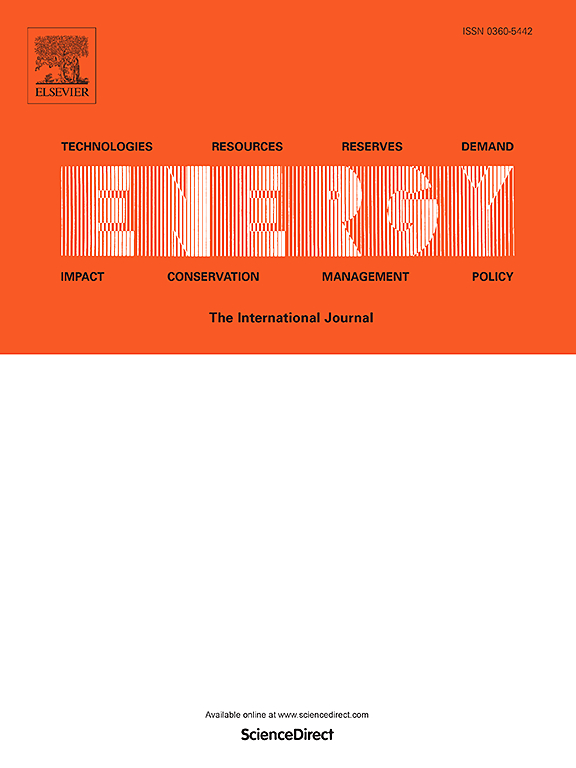Hybrid energy system for reverse osmosis desalination: Kalina cycle power from an abandoned oil well with hydrogen and battery backup during geothermal well maintenance
IF 9
1区 工程技术
Q1 ENERGY & FUELS
引用次数: 0
Abstract
This study evaluates the integration of geothermal abandoned oil wells for power generation and desalination, addressing the dual challenges of energy and water scarcity. Using advanced simulation tools—Engineering Equation Solver for the Kalina cycle system 11, Wave for the reverse osmosis system, and HOMER for hybrid energy optimization—the research integrates geothermal power, battery storage, and hydrogen storage. The geothermal Kalina cycle system 11 generates efficient power using a water-ammonia mixture, producing 210 kWh at 15 bars and 215 kWh at 20 bars. Exergy analysis showed that higher pressures enhanced system efficiency, compactness, and resilience. The two-stage reverse osmosis system, with a recovery rate of 55 %, produced 805.1 m3/day of potable water at a specific energy consumption of 4.78 kW/m3, confirming its energy-efficient operation. An optimized strategy, developed using HOMER, limited geothermal Kalina cycle system 11 shutdowns from one month a year to a week every three months. During these outages, a hybrid energy solution involving 1146 kg of hydrogen storage and 10,500 12-V batteries ensured reliable operation of the reverse osmosis system, minimizing costs. The hybrid system demonstrated the complementary roles of hydrogen and batteries. While hydrogen storage provided 14,920 kWh/year, the battery system efficiently supplied the reverse osmosis's energy needs for up to seven days. This study validates the technical and economic feasibility of integrating the geothermal Kalina cycle system 11 with hybrid energy storage and desalination technologies, highlighting the importance of simulation tools in optimizing integrated energy-water systems.
用于反渗透海水淡化的混合能源系统:Kalina循环电力来自废弃油井,在地热井维护期间使用氢气和备用电池
本研究评估了地热废弃油井用于发电和海水淡化的整合,解决了能源和水资源短缺的双重挑战。利用先进的模拟工具——Kalina循环系统的工程方程求解器,反渗透系统的Wave和混合能源优化的HOMER——该研究集成了地热发电、电池存储和氢存储。地热Kalina循环系统11利用水-氨混合物产生高效电力,在15巴时产生210千瓦时,在20巴时产生215千瓦时。火用分析表明,较高的压力提高了系统的效率、紧凑性和弹性。两级反渗透系统的回收率为55%,日饮用水产量为805.1 m3,比能耗为4.78 kW/m3,运行节能。利用HOMER开发的优化策略,将地热Kalina循环系统的关闭次数从每年一个月减少到每三个月一周。在这些中断期间,包括1146公斤氢气储存和10,500块12v电池的混合能源解决方案确保了反渗透系统的可靠运行,最大限度地降低了成本。混合动力系统展示了氢和电池的互补作用。而氢气储存提供14920千瓦时/年,电池系统有效地为反渗透提供长达7天的能源需求。本研究验证了地热Kalina循环系统11与混合储能和海水淡化技术集成的技术和经济可行性,强调了模拟工具在优化集成能源-水系统中的重要性。
本文章由计算机程序翻译,如有差异,请以英文原文为准。
求助全文
约1分钟内获得全文
求助全文
来源期刊

Energy
工程技术-能源与燃料
CiteScore
15.30
自引率
14.40%
发文量
0
审稿时长
14.2 weeks
期刊介绍:
Energy is a multidisciplinary, international journal that publishes research and analysis in the field of energy engineering. Our aim is to become a leading peer-reviewed platform and a trusted source of information for energy-related topics.
The journal covers a range of areas including mechanical engineering, thermal sciences, and energy analysis. We are particularly interested in research on energy modelling, prediction, integrated energy systems, planning, and management.
Additionally, we welcome papers on energy conservation, efficiency, biomass and bioenergy, renewable energy, electricity supply and demand, energy storage, buildings, and economic and policy issues. These topics should align with our broader multidisciplinary focus.
 求助内容:
求助内容: 应助结果提醒方式:
应助结果提醒方式:


